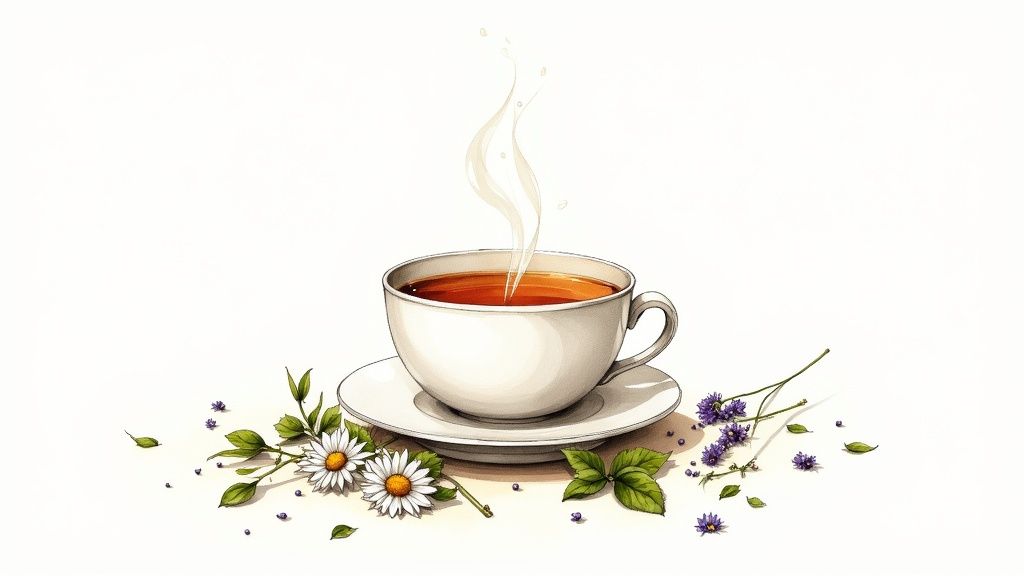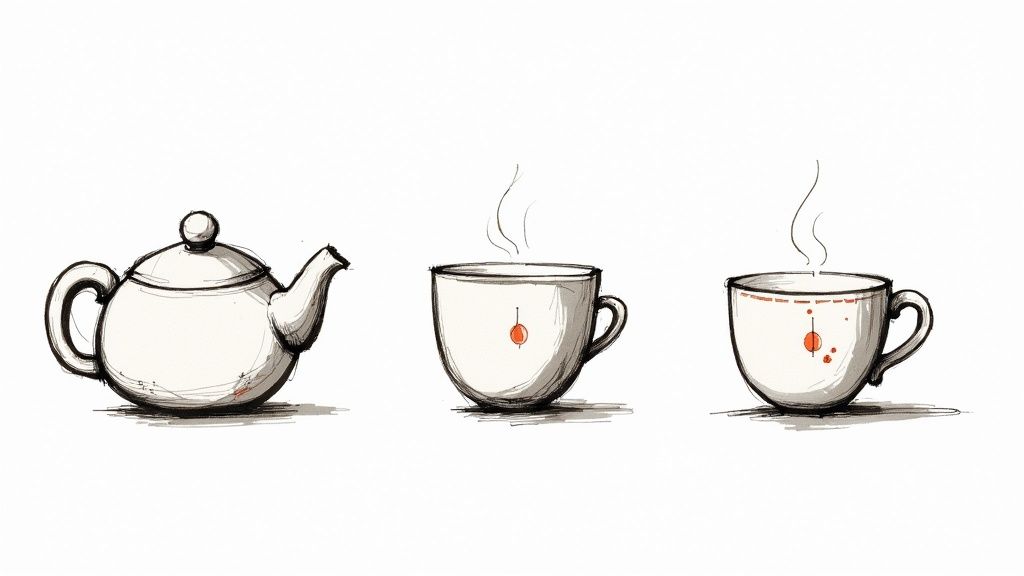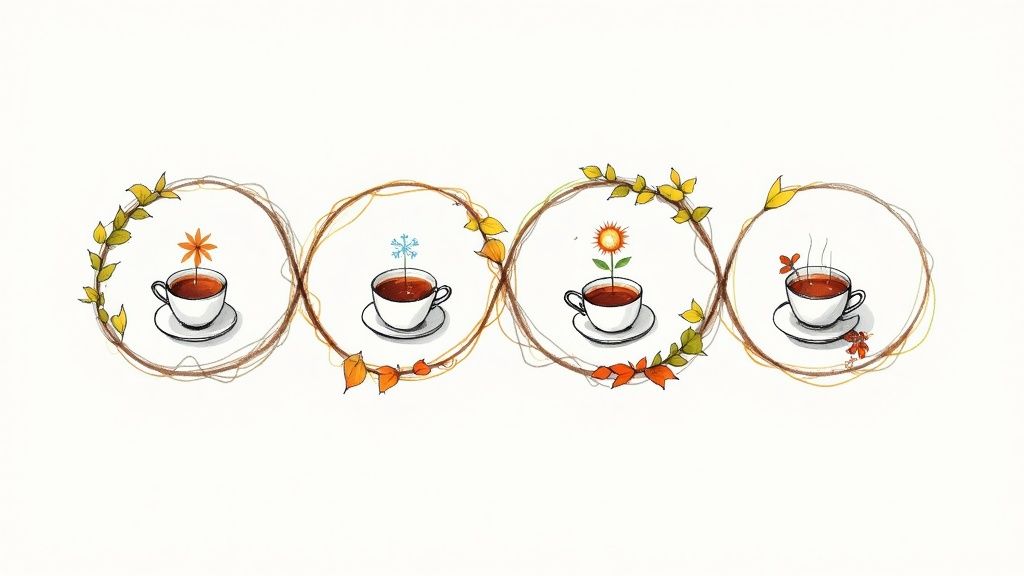Introduction to Herbal Teas

From ancient ceremonies to modern wellness practices, tea holds a significant place in global cultures. While true teas like black, green, white, and oolong all come from the Camellia sinensis plant, herbal teas offer a diverse and exciting world of flavors and potential wellness advantages. These teas come from various plants, spices, and fruits, making their exploration a fascinating journey for both taste and well-being.
What Exactly are Herbal Teas?
Herbal teas, often called tisanes, aren't actually "tea" in the strictest sense. They are infusions or decoctions made from different parts of plants, including leaves, flowers, roots, bark, and even seeds. Imagine steeping a handful of spices or a small bouquet of flowers in hot water. The resulting liquid absorbs the plant's unique properties, creating a flavorful, and often aromatic, beverage. This process naturally results in a caffeine-free drink, offering a soothing alternative to traditional caffeinated beverages. For instance, chamomile tea before bed can encourage relaxation, while a cup of peppermint tea after a meal may support digestion. This natural approach to flavor and wellness has led to a growing interest in the many varieties of herbal teas.
The Expanding World of Herbal Teas
The rising interest in herbal teas reflects a growing appreciation for their potential health benefits and the wide range of flavors they offer. The spectrum is vast, from the gentle floral hints of chamomile and lavender to the invigorating zest of ginger and lemongrass. Furthermore, herbal teas can be enjoyed both hot and iced, offering refreshment throughout the year. This adaptability, coupled with the absence of caffeine, makes these teas an attractive option for people of all ages and lifestyles. The demand for herbal teas also fuels a dynamic market, constantly innovating with unique blends, exciting new flavor combinations, and potential wellness advantages. Discovering this world of herbal infusions opens up a wealth of possibilities for improving daily routines and overall well-being.
Health Benefits of Herbal Teas

Exploring the world of herbal teas is more than just a flavorful experience; it’s a journey into the potential health benefits they offer. Since each herbal tea comes from a unique plant source, every cup holds distinct wellness properties. This variety makes discovering different herbal teas a rewarding experience for those seeking natural ways to enhance their well-being.
Antioxidant Powerhouses
Many herbal teas are brimming with antioxidants, substances that protect the body from damage caused by free radicals. These unstable molecules can contribute to cell damage and various health concerns. Antioxidants act as protective shields against these harmful effects. For instance, the vibrant color and tart flavor of hibiscus tea come from anthocyanins, which are potent antioxidants. Similarly, rooibos tea, with its naturally sweet, earthy notes, is another excellent source of these beneficial compounds. Consequently, including antioxidant-rich herbal teas in your diet can contribute to your overall health.
Soothing Digestive Aid
Certain herbal teas can also provide support for healthy digestion. Peppermint tea, with its menthol content, is a well-known choice for calming indigestion and reducing bloating. The menthol helps relax the digestive tract muscles, easing discomfort and aiding digestion. Ginger tea is another excellent option, known for its anti-inflammatory properties and its ability to soothe nausea. This makes ginger tea a helpful remedy for motion sickness or morning sickness. Such digestive benefits contribute to the increasing popularity of herbal teas as natural digestive aids.
Stress Reduction and Relaxation
In our busy modern lives, stress management is essential. Herbal teas provide a gentle and natural way to unwind and promote relaxation. Chamomile tea, with its delicate floral aroma, is a classic choice for calming the nerves and preparing for a good night's sleep. Its soothing effects create a sense of tranquility. Similarly, lavender tea offers calming properties that may help ease anxiety and improve sleep quality. This makes calming herbal teas like chamomile and lavender valuable tools for stress management and relaxation. You might be interested in: The health benefits of matcha tea.
Immune System Support
Some herbal teas possess properties that may support immune function. Echinacea tea, for instance, is traditionally used to combat colds and flu, potentially stimulating the immune system and bolstering the body’s natural defenses. Elderflower tea, rich in antioxidants, is another option that may contribute to overall immune health. Therefore, incorporating these teas into your diet, especially during cold and flu season, could provide additional immune support. Exploring these various herbal teas reveals natural options for supporting overall well-being.
Popular Herbal Tea Varieties
Exploring different herbal teas is like embarking on a global culinary adventure. Each type possesses unique flavors, aromas, and potential wellness benefits. This variety makes discovering new herbal teas an exciting experience. From the calming notes of chamomile to the zesty kick of ginger, there's a world of flavor waiting to be explored.
Floral Infusions
Floral infusions offer a delicate and aromatic experience, often promoting relaxation and tranquility. They are a perfect choice for unwinding after a busy day or enjoying a peaceful moment.
- Chamomile: Known for its gentle, apple-like flavor, chamomile tea is a well-loved remedy for promoting relaxation and better sleep. It's like a warm, comforting hug in a mug, soothing your nerves and promoting calm.
- Lavender: With its distinct floral aroma and subtle sweetness, lavender tea shares chamomile's calming benefits. It may also help reduce anxiety and promote a sense of well-being, making it an excellent choice for natural stress relief.
- Rose: Rose tea's subtle floral notes and delicate sweetness add a touch of elegance to any tea time. Beyond its pleasing flavor, rose tea is also believed to have anti-inflammatory properties, sometimes used to soothe sore throats.
- Hibiscus: This tart and vibrant tea, with its deep red color, is a refreshing twist on floral infusions. Hibiscus is rich in antioxidants and is sometimes associated with maintaining healthy blood pressure.
Earthy and Spicy Blends
Earthy and spicy blends offer a bolder, more invigorating experience. These teas often include ingredients known for their warming and digestive properties, making them a good choice for cooler weather or after meals.
- Ginger: Ginger tea, with its pungent, spicy flavor, is a common remedy for nausea and digestive issues. Think of it as jumpstarting your digestive system, promoting healthy function. It also boasts anti-inflammatory properties, further enhancing its wellness potential.
- Turmeric: Turmeric tea's earthy flavor and bright golden color signal its health benefits. The potent anti-inflammatory compound curcumin may support joint health and boost the immune system.
- Cinnamon: The warmth and comfort of cinnamon spice add a touch of sweetness and familiar aroma to tea. Cinnamon tea is often associated with supporting healthy blood sugar levels and offering antioxidant benefits. Combining it with other spices like ginger or cardamom creates an even more complex flavor.
Refreshing and Cooling Options
For a lighter, more refreshing experience, especially in warmer months, cooling herbal teas are a perfect choice. These teas often feature citrusy or minty notes.
- Peppermint: Peppermint tea's invigorating and cooling sensation makes it a popular choice for supporting digestion and relieving headaches. The menthol provides a soothing, cooling effect.
- Lemongrass: Lemongrass tea, with its bright citrusy aroma and slightly sweet flavor, is both refreshing and uplifting. It's also believed to have calming and pain-relieving properties, making it a good choice for a natural mood boost.
- Rooibos: Rooibos tea, originating from South Africa, has a naturally sweet and slightly earthy flavor. Caffeine-free and packed with antioxidants, rooibos can be enjoyed any time of day as a healthy alternative to caffeinated beverages.
This exploration only scratches the surface of the vast world of tisanes. With a wide range of varieties and blends to discover, experimenting with these flavorful and potentially health-promoting beverages can be a rewarding journey for both your taste buds and well-being. From the invigorating spice of ginger to the calming floral notes of chamomile, exploring these diverse options can enrich your daily life.
How to Brew the Perfect Cup

Now that we've explored the world of herbal teas, from the invigorating ginger to the soothing chamomile, let's learn how to brew the perfect cup. Proper brewing techniques are crucial for unlocking the full flavor and aroma of these delightful beverages. This ensures maximum enjoyment and potential benefits from each cup. Just as a chef uses precise measurements and cooking times, brewing herbal tea requires attention to detail.
Water Temperature: The Key to Flavor
Water temperature is essential for extracting the optimal flavor from your herbal tea. Using boiling water for delicate florals like chamomile or lavender can scorch the petals, creating a bitter taste. Think of it like cooking vegetables – too much heat can ruin the texture and flavor. On the other hand, heartier herbs and roots like ginger and turmeric benefit from hotter water to release their full potential. Therefore, adjusting the water temperature based on the type of herbal tea you're brewing is key to a balanced and flavorful cup.
Steep Time: Finding the Sweet Spot
Steep time, the length of time the herbs infuse in hot water, is another critical element. Over-steeping can result in a bitter taste, while under-steeping can leave the tea weak and flavorless. Delicate floral teas like chamomile typically need a shorter steep time of 3-5 minutes, while heartier herbs like ginger can steep for 7-10 minutes or longer. Finding the perfect steep time for each tea unlocks its optimal flavor profile. Experimentation and personal preference will guide you to the ideal steeping duration.
Brewing Methods: From Traditional to Modern
Herbal teas can be brewed using various methods, from classic teapots and infusers to modern techniques like French presses and cold brewing. Traditional teapots, crafted from ceramic or porcelain, offer an elegant brewing experience. Infusers, whether simple mesh balls or more intricate designs, provide easy steeping and removal of the herbs. Even a French press, typically used for coffee, can brew a strong and flavorful herbal tea. This versatility allows you to adapt your brewing method to your preference and the specific type of tea. For iced tea enthusiasts, cold brewing is a great option, steeping the herbs in cold water for 12-24 hours. This method yields a smoother, less bitter iced tea with a more nuanced flavor. It also minimizes the risk of over-steeping.
Enhancing Your Herbal Tea Experience
Beyond these basic techniques, there are many ways to enhance your tea experience. A touch of honey or maple syrup can complement the natural sweetness of some teas, while a squeeze of lemon or lime can brighten others. Experimenting with different blends and combinations can also lead to new flavor discoveries. For example, ginger and turmeric together create a warming and invigorating blend with potent anti-inflammatory properties. This customization allows you to personalize each cup to your taste and wellness goals.
Seasonal Tea Guide

Just as our food preferences change with the seasons, so can our tea choices. Different herbal teas offer unique characteristics that complement the weather and our bodies' needs throughout the year. Exploring seasonal tea variations adds a delightful dimension to your tea-drinking routine, much like choosing clothing appropriate for the weather.
Spring Awakening with Floral Teas
As winter fades and spring emerges, the delicate floral notes of certain herbal teas perfectly capture the season of renewal. Spring is the ideal time to enjoy the lighter, brighter flavors of floral infusions. Rose tea embodies the essence of blooming gardens, while chamomile tea offers a calming transition from the colder months. These teas gently usher in the warmth of spring.
Summer Refreshment with Cooling Blends
When summer's heat intensifies, refreshing and cooling herbal teas are a welcome treat, helping you stay hydrated and beat the heat. Peppermint tea, with its invigorating menthol, offers a cooling sensation. Lemongrass tea provides a zesty and uplifting experience, reminiscent of sunshine and citrus. These teas are a delicious way to stay cool and refreshed during summer.
Autumn Comfort with Warming Spices
As the leaves change and the air becomes crisp, the warming spices of autumnal teas provide comfort and grounding. Autumn is the perfect time to enjoy the earthy and spicy notes of ginger and cinnamon. Ginger tea's pungent warmth offers a cozy feeling, like a warm fire on a cool evening. Cinnamon tea's sweet aroma evokes feelings of warmth and holiday cheer. These teas create a sense of well-being as the days grow shorter.
Winter Wellness with Immune-Boosting Teas
During winter, when colds and flu are more common, certain herbal teas can provide extra immune support. This makes winter an opportune time to explore teas with potential wellness benefits. Echinacea tea, traditionally used to bolster the body’s defenses, and elderflower tea, with its rich antioxidant content, can be valuable allies in promoting wellness throughout the cold and flu season. Choosing the right herbal tea for each season allows you to fully appreciate their flavors and potential health benefits, creating a more enriching tea-drinking experience.
Storage and Preservation
From vibrant hibiscus to soothing chamomile, herbal teas offer a wide array of flavors and potential benefits. To fully savor these nuances, proper storage is crucial, just as proper care preserves the freshness of garden herbs. Correct storage ensures that each cup delivers the intended flavor and aroma.
Protecting Your Herbal Teas from the Elements
Light, air, and moisture can degrade the quality of your herbal teas, much like sunlight fades a painting. Therefore, store them in airtight containers away from direct sunlight and humidity. Clear glass jars, while attractive, can allow light to penetrate, diminishing the tea’s quality. Opaque containers made of ceramic, metal, or dark-colored glass provide better protection. Storing tea in a cool, dry place, like a pantry or cupboard, further safeguards its freshness.
Maintaining Optimal Flavor and Aroma
Different herbal teas have different shelf lives. Dried herbs and spices generally last up to a year, but delicate floral teas like chamomile and lavender may have a shorter lifespan. Pay attention to "best by" dates and avoid storing different teas together in the same container, as stronger aromas can overpower more delicate varieties. This is similar to storing spices – you wouldn’t want strong spices overpowering delicate ones. Separating your teas ensures each variety retains its unique flavor profile.
Reviving Stale Herbal Teas
Even with proper storage, teas can sometimes lose their vibrancy. Gently warming stale tea leaves in a dry pan over low heat can release their essential oils and restore some potency, similar to toasting spices. Avoid overheating, which can scorch the leaves and create bitterness. By following these storage tips, you can ensure your herbal teas remain fresh and flavorful.
Conclusion
From the invigorating zest of ginger to the soothing comfort of chamomile, this exploration of herbal teas has unveiled a world of diverse flavors and potential health benefits. We've journeyed through the calming effects of floral infusions like lavender and rose, the earthy and spicy notes of ginger and turmeric, and the refreshing coolness of peppermint and lemongrass. We've also discussed how water temperature and steep time impact flavor, enabling you to personalize each cup. Exploring seasonal variations, like the warming spices of cinnamon in autumn or the immune-supporting properties of echinacea in winter, further enhances the tea-drinking experience.
Embracing the World of Herbal Teas
This diverse world of herbal teas provides a unique way to enhance your daily routine and overall well-being. Incorporating calming chamomile tea into your evening routine can promote relaxation and better sleep, while starting your day with refreshing peppermint tea can aid digestion. Herbal teas can be seamlessly integrated into your lifestyle to support various aspects of your health and wellness. These caffeine-free beverages can be enjoyed any time of day. Proper storage enhances the tea-drinking experience, ensuring each cup delivers the intended aroma and flavor. Just as a gardener cares for their plants, taking care of your herbal teas preserves their freshness and potency.
This exploration has only scratched the surface of the vast and fascinating world of herbal teas. It serves as a starting point for your own tea discovery journey. By experimenting with different varieties, you can uncover new favorites, explore unique flavor combinations, and discover the potential wellness benefits they offer.
Ready to delve deeper into the world of tea? Explore the rich history, health benefits, and diverse varieties of matcha at matcha-tea.com. Discover a world of flavor and wellness waiting to be uncovered!
